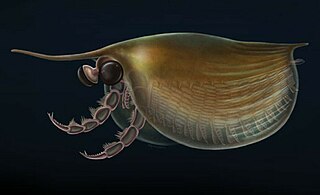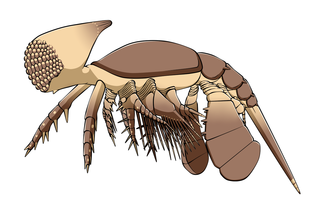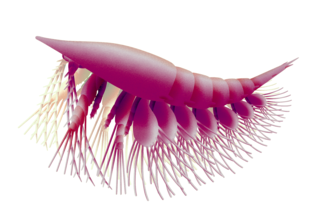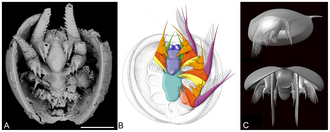
Yohoia is an extinct genus of megacheiran arthropod from the Cambrian period that has been found as fossils in the Burgess Shale formation of British Columbia, Canada. The type species, Yohoia tenuis, was described in 1912 by Walcott, who considered it an anostracan crustacean. 711 specimens of Yohoia are known from the Greater Phyllopod bed, where they comprise 1.35% of the community. In 2015, Conway Morris et al. reported another species, Y. utahana, from the Marjum Formation, Utah.

The Orsten fauna are fossilized organisms preserved in the Orsten lagerstätte of Cambrian rocks, notably at Kinnekulle and on the island of Öland, all in Sweden.

Waptia is an extinct genus of arthropod from the Middle Cambrian of North America. It grew to a length of 6.65 cm (3 in), and had a large bivalved carapace and a segmented body terminating into a pair of tail flaps. It was an active swimmer and likely a predator of soft-bodied prey. It is also one of the oldest animals with direct evidence of brood care. Waptia fieldensis is the only species classified under the genus Waptia, and is known from the Burgess Shale Lagerstätte of British Columbia, Canada. Specimens of Waptia are also known from the Spence Shale of Utah, United States.

The (pan)arthropod head problem is a long-standing zoological dispute concerning the segmental composition of the heads of the various arthropod groups, and how they are evolutionarily related to each other. While the dispute has historically centered on the exact make-up of the insect head, it has been widened to include other living arthropods, such as chelicerates, myriapods, and crustaceans, as well as fossil forms, such as the many arthropods known from exceptionally preserved Cambrian faunas. While the topic has classically been based on insect embryology, in recent years a great deal of developmental molecular data has become available. Dozens of more or less distinct solutions to the problem, dating back to at least 1897, have been published, including several in the 2000s.

Megacheira is an extinct class of predatory arthropods defined by their possession of spined "great appendages". Their taxonomic position is controversial, with studies either considering them stem-group euarthropods, or stem-group chelicerates. The homology of the great appendages to the cephalic appendages of other arthropods is also controversial. Uncontested members of the group were present in marine environments worldwide from the lower to middle Cambrian.

Chuandianella ovata is an extinct bivalved arthropod that lived during Cambrian Stage 3 of the Early Cambrian. It is the only species classified under the genus Chuandianella. Its fossils were recovered from the Chengjiang Biota in Yunnan, China.

Ercaicunia is genus of bivalved Cambrian arthropod from the Chengjiang biota of Yunnan, China. It contains a single species, E. multinodosa that was described by Luo et al. in 1999. The total length of the body ranges from 8 to 11 millimetres. The bivalved carapace covered about a third of the total body-length, and has up to six serrations on its forward edge. The head has a pair of large uniramous antennae, as well as a smaller pair of secondary antennae, as well as pair of mandibles and maxillae. The trunk has 16 pairs of biramous appendages. Specimens were CT scanned in 2019, which suggested it to be a stem-group crustacean. Other subsequent studies have recovered it as a member of Hymenocarina, which contains other bivalved Cambrian arthropods.

Haikoucaris is a genus of megacheiran arthropod that contains the single species Haikoucaris ercaiensis. It was discovered in the Cambrian Chengjiang biota of China.

Isoxys is a genus of extinct bivalved Cambrian arthropod; the various species of which are thought to have been freely swimming predators. It had a pair of large spherical eyes, and two large frontal appendages used to grasp prey.

Bradoriida, also called bradoriids, are an extinct order of small marine arthropods with a bivalved carapace, which globally distributed, forming a significant portion of the Cambrian and Early Ordovician soft-bodied communities.

The Comley Limestone is an Early Cambrian Lagerstätte exposed in Comley, Shropshire, England. It is known for its phosphatic microfossils, which can be extracted by acid maceration and are preserved in three dimensions in a similar fashion to the Orsten fossils. It represents around 10 million years of deposition, and was deposited from 519 to 501 million years ago. Fossils from the formation include the phosphatocopine arthropod Klausmuelleria.
Skara is a genus of maxillopod crustacean known from the Upper Cambrian Orsten deposit of Sweden and similarly aged deposits in China. It is the only genus in the order Skaracarida and family Skaraidae, and contains three species:

Tokummia is a genus of fossil hymenocarine arthropod, known only by one species, Tokummiakatalepsis, from the middle Cambrian Burgess Shale as found in a quarry in Marble Canyon in Canada.

Kylinxia is a genus of extinct arthropod described in 2020. It was described from six specimens discovered in Yu'anshan Formation in southern China. The specimens are assigned to one species Kylinxia zhangi. Dated to 518 million years, the fossils falls under the Cambrian period. Announcing the discovery on 4 November 2020 at a press conference, Zeng Han of the Nanjing Institute of Geology and Paleontology, said that the animal "bridges the evolutionary gap from Anomalocaris to true arthropods and forms a key ‘missing link’ in the origin of arthropods," which was "predicted by Darwin’s evolutionary theory." The same day the formal description was published in Nature.

Cambropachycope is a genus of small extinct Cambrian arthropods, known from the Orsten lagerstätten in southern Sweden. It appears to have several apomorphic features, notably including a single large compound eye.

Jugatacaris is an extinct genus of bivalved arthropod known from a single species, Jugatacaris agilis found in the Cambrian Stage 3 aged Chengjiang biota of Yunnan, China. The carapace is around 28 to 37 millimetres in length, with a pronounced ridge at the top of the carapace separating the two valves, which formed a fin-like structure raised above the carapace. The head has a pair of stalked eyes, as well as a dumbbell shaped medial eye between them. The head also bore a pair of mandibles as well as at least one and possibly two pairs of antennules. The trunk had up to 65 segments, each with biramous appendages. The appendages had thin endopods with 30 podomeres, each bearing a spiny endite, with the endopods ending with a terminal claw. The appendages also had overlapping flap-like exopods, which are elongated, being at maximum eight times as long as they are wide, which on their posterior edge are covered with setae. The trunk ended with a forked tail. It was likely an actively swimming filter feeder, using its constantly beating appendages to sift food from the water column, which was then passed forward along the U-shaped food groove between the appendage pairs towards the mouth. While initially placed as a crustaceanomorph, later studies considered to be a member of Hymenocarina, which contains numerous other similar bivalved Cambrian arthropods.

Oelandocaris is an extinct genus of stem-mandibulate, or possibly a megacheiran, within the monotypic family Oelandocarididae.

Goticaris is a genus of small extinct Cambrian arthropods, known from the Orsten lagerstätten in southern Sweden. It appears to have several apomorphic features, notably including a single large compound eye.
Martinssonia is an extinct genus of Cambrian arthropod from the Orsten Lagerstätte.
Musacaris is an extinct genus of Cambrian arthropod from the Orsten Lagerstätte, formerly synonymous with Martinssonia. It contains only a single species, Musacaris gerdgeyeri.


















